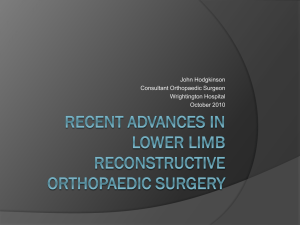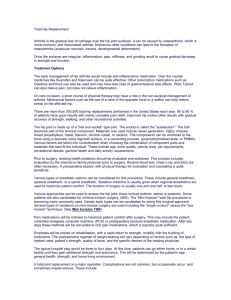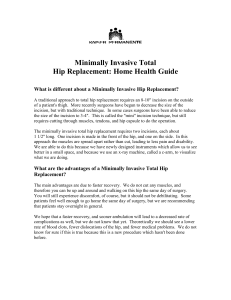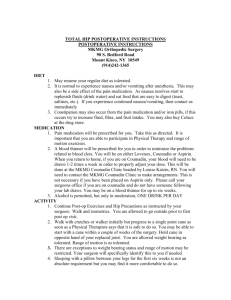Total Knee Patient Handout
advertisement
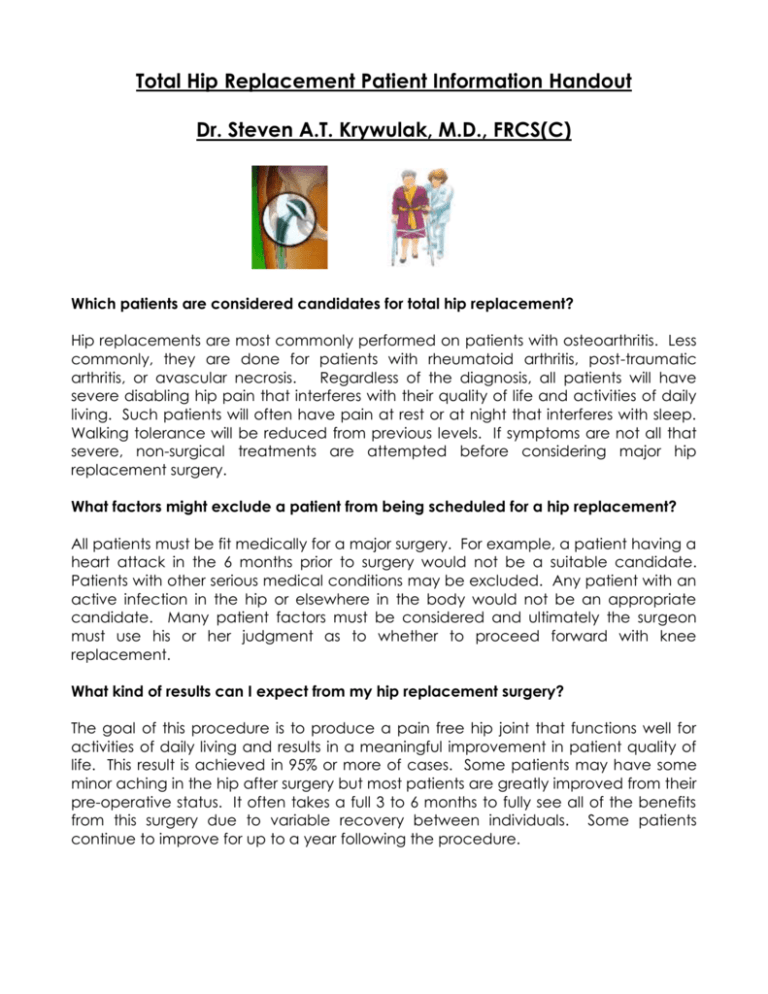
Total Hip Replacement Patient Information Handout Dr. Steven A.T. Krywulak, M.D., FRCS(C) Which patients are considered candidates for total hip replacement? Hip replacements are most commonly performed on patients with osteoarthritis. Less commonly, they are done for patients with rheumatoid arthritis, post-traumatic arthritis, or avascular necrosis. Regardless of the diagnosis, all patients will have severe disabling hip pain that interferes with their quality of life and activities of daily living. Such patients will often have pain at rest or at night that interferes with sleep. Walking tolerance will be reduced from previous levels. If symptoms are not all that severe, non-surgical treatments are attempted before considering major hip replacement surgery. What factors might exclude a patient from being scheduled for a hip replacement? All patients must be fit medically for a major surgery. For example, a patient having a heart attack in the 6 months prior to surgery would not be a suitable candidate. Patients with other serious medical conditions may be excluded. Any patient with an active infection in the hip or elsewhere in the body would not be an appropriate candidate. Many patient factors must be considered and ultimately the surgeon must use his or her judgment as to whether to proceed forward with knee replacement. What kind of results can I expect from my hip replacement surgery? The goal of this procedure is to produce a pain free hip joint that functions well for activities of daily living and results in a meaningful improvement in patient quality of life. This result is achieved in 95% or more of cases. Some patients may have some minor aching in the hip after surgery but most patients are greatly improved from their pre-operative status. It often takes a full 3 to 6 months to fully see all of the benefits from this surgery due to variable recovery between individuals. Some patients continue to improve for up to a year following the procedure. What are the risks and complications associated with hip replacement surgery? Hip replacement is not without risk. A patient must carefully consider the risks and benefits of surgery prior to giving informed consent. The following list includes the most commonly encountered complications of hip replacement surgery. They are divided into major and minor complications. Major complications can result in loss of life or limb. Minor complications can vary in severity from those causing significant difficulty to those causing minor inconvenience to the patient. No list of complications can include every known possible adverse event. If you have any further questions or concerns, be sure to ask your surgeon. Major Risks - heart attack -stroke -pulmonary embolism - infection - bleeding requiring transfusion - allergic reaction to the anesthetic/antibiotics Minor Risks - nerve injury causing numbness or weakness in the foot - fracture of the femur -blood clots in legs - post-operative confusion -pneumonia - dislocation of the hip after surgery (rare) - leg length discrepancy Most complications can be successfully treated with little or no impact on the final result for the patient. Patients are routinely given antibiotics to prevent infection and blood thinners to help prevent blood clots/pulmonary embolism. It is important to stop your anti-inflammatory medication a week prior to surgery to prevent increased bleeding unless you are taking Celebrex. If you are unsure, about this, simply ask your doctor. Note: Most patients can expect swelling in the knee and foot for 3-6 months after surgery. Is it possible that my legs might not be the same length after surgery? Unfortunately the answer is yes. Every effort is made during the operation to even out leg lengths equally. This is not always as easy as it sounds. Many patients note that their arthritic leg is shorter before surgery. This happens when the cartilage of the joint wears out and can be worsened if bony collapse occurs. When the hip replacement is done, bone is taken away from the ball and socket portions of the joint. This bone is replaced with the metal and plastic components. A surgeon must then alter the femoral component length to obtain stability and sometimes the leg is lengthened to keep enough soft tissue tension in order to prevent the hip from dislocating. Most patients who have leg length discrepancies after surgery have minor ones of about 1 cm. This is usually not noticeable for the patient. Rarely a patient will have up to two centimeters difference and may require a shoe lift on the non-operative side to balance the pelvis. Will I be getting a cemented or uncemented hip replacement? When it comes to the cup (socket) portion of the replacement, all of these are uncemented components placed in with a press fit. The sockets are placed in fairly tightly, but in some cases a few screws may be used to secure the cup. Your own bone will eventually grow into the rough surface of the implant to secure it permanently. Most of the femoral components in Kelowna are also placed in without cement. In certain rare patients with poor bone quality, a smooth femoral component will be used with bone cement at the surgeon’s discretion. How painful is this procedure? Most patients find hip replacement to be moderately painful, especially for the first week. Some patients have very little pain after surgery. You will receive long and short acting narcotics along with Tylenol and an anti-inflammatory immediately postop. By the third or fourth day, patients are typically on milder pain killers in pill form, and most will go home on these pills. Many patients will have the majority of their pain resolve by 12 weeks post-operatively. Rarely, some patients may take a full six months or more before their comfort level plateaus. Each individual responds differently and sometimes a little patience is required. How long will I be in hospital after surgery? Typically, most patients are in hospital for 2-4 days. If a patient requires a longer stay to recover, they may be transferred to a rehabilitation or transitional unit for further care. Due to hospital bed shortages, stays longer than 5 days are avoided whenever possible so that other patients do not have their surgery cancelled due to lack of beds on the ward. Will I need physiotherapy after surgery? Yes, all patients will be seen by the physiotherapy team while in hospital. You may be up walking the same day as your surgery. On discharge, patients are encouraged to see a physiotherapist to assist with their leg exercises. Outpatient physiotherapy is somewhat limited at the hospital but enquiries can be made to access this service. Many patients will choose to see a physiotherapist in the community, but this service is not covered under the provincial health plan and is prohibitively expensive for some patients. Patients who can’t make it out of their home may arrange to have a home physiotherapist visit them postoperatively. This is covered under provincial health care but the number of visits you will receive is also limited. What restrictions will I have after hip replacement surgery? You will be permitted to shower over the wound by the second day in hospital. Bathing is not permitted until 5 days after the staples have been removed as long as the incision is full healed over. Staples come out on Day 10 typically. Keep the wound clean and dry. Most patients are allowed to take full weight through the hip immediately, but usually require crutches or a walker until more stable. You may want to rearrange furniture or sleeping arrangements in your home to accommodate a walker and avoid stairs. You may require a chair in the shower or other assistive devices. A raised toilet seat is important to avoid excessive bending of the hip that may cause hip dislocation. A pillow between the legs during sleep is suggested for 3 months, also to prevent dislocation. Driving is not permitted for 6-9 weeks if the right hip is done. You should be confident in using the leg to brake in an emergency. If you use a car with an automatic transmission, and the left hip is replaced, driving may be permitted by 2-6 weeks post-operatively. Return to work depends on the type of work done. Six weeks for return to a desk job and 3 months for other types of employment are general guidelines. Mobility will be restricted after surgery and arrangements for personal care, bathing, meals etc. should be made before surgery if possible. You can walk as much as you like. Sexual activity is permitted at 6 weeks or thereafter depending on patient comfort. It is possible that airport metal detectors will sense your hip prosthesis. There is no documentation for security and this should pose no issue in most cases. What activities can I do once I am fully recovered from surgery? The purpose of this procedure is to help patients become more active, therefore we do encourage activity. However, high impact activities are not recommended as they may significantly decrease the lifespan of the implant, necessitating revision surgery. The following list serves as a guideline, but each case must be individualized to the patient. If you have questions, ask your surgeon. How long will my hip replacement last? No one can predict this for sure. Individual patients vary in size, weight and the demands they place on their implants. Certainly, patients under the age of 65 will place increased demands on their implants creating concerns about longevity. Typically, a total hip replacement can be expected to last 15 years minimum. In lower demand patients, they may last 20 years or longer. X-ray follow-up may be required in younger patients who are more likely to wear out their hip in their lifetime. Some newer implants are available for younger or higher demand patients that may improve survivorship in the long run. The use of these “premium” implants will be discussed with you prior to surgery if you are a candidate. In certain cases, there will be a charge to the patient for upgraded or premium implants. If you have any questions regarding these implants, you can make an appointment to discuss them with your surgeon. _____________________________________________ Dr. Steven Krywulak

